
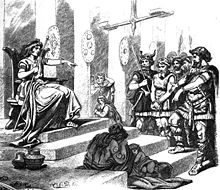
Forseti (Old Norse "the presiding one", "president" in modern Icelandic and Faroese) is the god of justice and reconciliation in Norse mythology. He is generally identified with Fosite, a god of the Frisians.


Forseti (Old Norse "the presiding one", "president" in modern Icelandic and Faroese) is the god of justice and reconciliation in Norse mythology. He is generally identified with Fosite, a god of the Frisians.
Grimm took Forseti, "praeses, princeps", to be the older form of the name, first postulating the Old High German equivalent *forasizo (cf. modern German Vorsitzender "one who presides", Old English fore-sittan 'to preside'). [1] but later preferring a derivation from fors, a "whirling stream" or "cataract", connected to the spring and the god's veneration by seagoing peoples. [2] It is plausible that Fosite is the older name and Forseti a folk etymology. [3] According to the German philologist Hans Kuhn the Germanic form Fosite is linguistically identical to Greek Poseidon , hence the original name may have been introduced before the Proto-Germanic sound change, possibly via Greek sailors purchasing amber (cf. Phol as a cognate of Baldr ). [4] [5] The etymologist Wolfgang Laur, is highly critical, however, as the names of Germanic gods are composed almost exclusively of Germanic components. According to Laur, the name Forseti remains largely unexplained. [6]
According to Snorri Sturluson in the Prose Edda, [7] Forseti is the son of Baldr and Nanna. His is the best of courts; all those who come before him leave reconciled. This suggests skill in mediation and is in contrast to his fellow god Týr, who "is not called a reconciler of men." [8] However, as de Vries points out, the only basis for associating Forseti with justice seems to have been his name; there is no corroborating evidence in Norse mythology. [9] 'Puts to sleep all suits' or 'stills all strifes' may have been a late addition to the strophe Snorri cites, from which he derives the information. [10]
The first element in the name Forsetlund (Old Norse Forsetalundr), a farm in the parish of Onsøy ('Odin's island'), in eastern Norway, seems to be the genitive case of Forseti, offering evidence he was worshipped there. [10] [11]
Glitnir (meaning "one who shines") [12] is the hall of Forseti, and the seat of justice amongst gods and men. It is also noted to have been a place of dwelling for Baldr, Forseti's father in Norse and Germanic mythologies. Glitnir is symbolic of the importance of discussion rather than violence as a means of resolution of conflict within the Norse tradition. It has pillars of gold and is roofed with silver, which radiated light that could be seen from a great distance. [13] The stories of Baldr and his son Forseti may have been contaminated with legends about king Guðmundr and his son Höfundr ('the judge'), who inhabited the otherworld land of Glæsisvellir.
According to Alcuin's Life of St. Willebrord, the saint visited an island between Frisia and Denmark that was sacred to Fosite and was called Fositesland after the god worshipped there. There was a sacred spring from which water had to be drawn in silence, it was so holy. Willebrord defiled the spring by baptizing people in it and killing a cow there. [10] Altfrid tells the same story of St. Liudger. [14] Adam of Bremen retells the story and adds that the island was Heiligland, i.e., Heligoland. [15]
There is also a late-medieval legend of the origins of written Frisian laws. Wishing to assemble written lawcodes for all his subject peoples, Charlemagne summoned twelve representatives of the Frisian people, the asega's ('law-speakers'), and demanded they recite their people's laws. When they could not do so after several days, he let them choose between death, slavery, or being set adrift in a rudderless boat. They chose the last and prayed for help, whereupon a thirteenth man appeared, with a golden axe on his shoulder. He steered the boat to land with the axe, then threw it ashore; a spring appeared where it landed. He taught them laws and then disappeared. [16] [17] The stranger and the spring have traditionally been identified with Fosite and the sacred spring of Fositesland.
This hypothesis has not met with universal acceptance. [18]
Jacob Grimm noted that if, as Adam of Bremen states, Fosite's sacred island was Heligoland, that would make him an ideal candidate for a deity known to both Frisians and Scandinavians, but that it is surprising he is never mentioned by Saxo Grammaticus. [19]
The German neofolk band Forseti named itself after the god. [20]
In the 2002 Ensemble Studios game Age of Mythology , Forseti is one of 9 minor gods Norse players can worship. [21] [22] [23]
In the Cthulhu Mythos fictional universe, created by horror writer H.P. Lovecraft, Forseti is often implied to be a Norse representation of Cthulhu, the judge of the Outer Gods.
In Nordic mythology, Asgard is a location associated with the gods. It appears in a multitude of Old Norse sagas and mythological texts. It is described as the fortified home of the Æsir gods, often associated with gold imagery. Many of the best-known Nordic gods are Æsir or live in Asgard such as Odin, Thor, Loki, and Baldr.

Baldr is a god in Germanic mythology. In Norse mythology, he is a son of the god Odin and the goddess Frigg, and has numerous brothers, such as Thor and Váli. In wider Germanic mythology, the god was known in Old English as Bældæġ, and in Old High German as Balder, all ultimately stemming from the Proto-Germanic theonym *Balðraz.
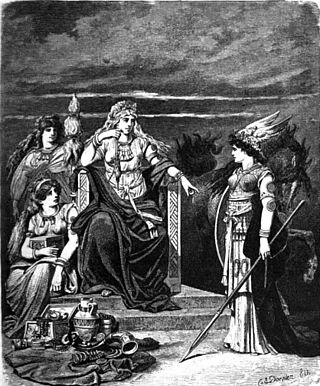
Frigg is a goddess, one of the Æsir, in Germanic mythology. In Norse mythology, the source of most surviving information about her, she is associated with marriage, prophecy, clairvoyance and motherhood, and dwells in the wetland halls of Fensalir. In wider Germanic mythology, she is known in Old High German as Frīja, in Langobardic as Frēa, in Old English as Frīg, in Old Frisian as Frīa, and in Old Saxon as Frī, all ultimately stemming from the Proto-Germanic theonym *Frijjō. Nearly all sources portray her as the wife of the god Odin.
In Norse mythology, Ginnungagap is the primordial, magical void mentioned in three poems from the Poetic Edda and the Gylfaginning, the Eddaic text recording Norse cosmogony.

Hel is a female being in Norse mythology who is said to preside over an underworld realm of the same name, where she receives a portion of the dead. Hel is attested in the Poetic Edda, compiled in the 13th century from earlier traditional sources, and the Prose Edda, written in the 13th century. In addition, she is mentioned in poems recorded in Heimskringla and Egils saga that date from the 9th and 10th centuries, respectively. An episode in the Latin work Gesta Danorum, written in the 12th century by Saxo Grammaticus, is generally considered to refer to Hel, and Hel may appear on various Migration Period bracteates.
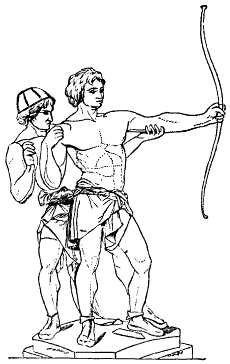
Höðr is a god in Norse mythology. The blind son of Odin and Frigg, he is tricked and guided by Loki into shooting a mistletoe arrow which was to slay the otherwise invulnerable Baldr.

The Norns are deities in Norse mythology responsible for shaping the course of human destinies.

Æsir or ēse are gods in Germanic paganism. In Old Nordic religion and mythology, the precise meaning of the term "Æsir" is debated, with it being able to refer to both the gods in general or specifically to one of the main families of gods, in contrast to the Vanir, with whom they waged war, ultimately leading to a joining of the families. The term can further be used to describe local gods that were believed to live in specific features in the landscape such as fells. In the Old English Wið færstice, the Ēse are referred to, along with elves, as harmful beings that could cause a stabbing pain, although exactly how they were conceived of by the author of the text is unclear.

In Norse mythology, Hlín is a goddess associated with the goddess Frigg. Hlín appears in a poem in the Poetic Edda, compiled in the 13th century from earlier traditional sources, the Prose Edda, written in the 13th century by Snorri Sturluson, and in kennings found in skaldic poetry. Scholars have debated whether the stanza referring to her in the Prose Edda refers to Frigg. Hlín serves as a given name in Iceland, and Hlín receives veneration in the modern era in Germanic paganism's modern extension, Heathenry.

In Norse mythology, Óðr or Óð, sometimes anglicized as Odr or Od, is a figure associated with the major goddess Freyja. The Prose Edda and Heimskringla, written in the 13th century by Snorri Sturluson, both describe Óðr as Freyja's husband and father of her daughter Hnoss. Heimskringla adds that the couple produced another daughter, Gersemi. A number of theories have been proposed about Óðr, generally that he is a hypostasis of the deity Odin due to their similarities.
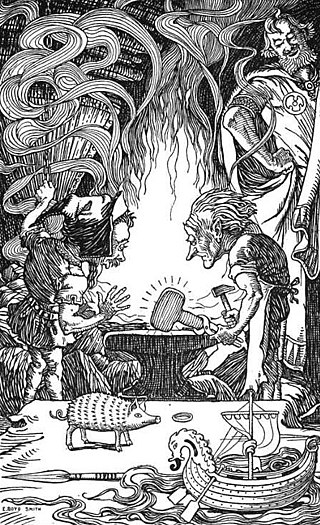
Gullinbursti, meaning "Gold Mane" or "Golden Bristles") is a boar in Norse mythology.
In Norse mythology, Borr or Burr was the son of Búri. Borr was the husband of Bestla and the father of Odin, Vili and Vé. Borr receives mention in a poem in the Poetic Edda, compiled in the 13th century from earlier traditional material, and in the Prose Edda, composed in the 13th century by Icelander Snorri Sturluson. Scholars have proposed a variety of theories about the figure.

Germanic paganism or Germanic religion refers to the traditional, culturally significant religion of the Germanic peoples. With a chronological range of at least one thousand years in an area covering Scandinavia, the British Isles, modern Germany, and at times other parts of Europe, the beliefs and practices of Germanic paganism varied. Scholars typically assume some degree of continuity between Roman-era beliefs and those found in Norse paganism, as well as between Germanic religion and reconstructed Indo-European religion and post-conversion folklore, though the precise degree and details of this continuity are subjects of debate. Germanic religion was influenced by neighboring cultures, including that of the Celts, the Romans, and, later, by the Christian religion. Very few sources exist that were written by pagan adherents themselves; instead, most were written by outsiders and can thus present problems for reconstructing authentic Germanic beliefs and practices.
In Norse mythology, Nanna Nepsdóttir or simply Nanna is a goddess associated with the god Baldr. Accounts of Nanna vary greatly by source. In the Prose Edda, written in the 13th century by Snorri Sturluson, Nanna is married to Baldr and the couple produced a son, the god Forseti.
Narfi, also Nörfi, Nari or Nörr, is a jötunn in Norse mythology, and the father of Nótt, the personified night.
In some versions of Norse mythology, Váli was one of the sons of Loki. He is mentioned in the Gylfaginning section of Snorri Sturluson's Prose Edda, chapter 50, possibly by confusion of a reference to Váli, son of Óðinn as binding Loki.

In Norse mythology, Himinbjörg is the home of the god Heimdallr. Himinbjörg is attested in the Poetic Edda, compiled from earlier traditional sources, and the Prose Edda and Heimskringla, both written in the 13th century by Snorri Sturluson. Himinbjörg is associated with Heimdallr in all sources. According to the Poetic Edda, Heimdallr dwells there as watchman for the gods and there drinks fine mead, whereas in the Prose Edda Himinbjörg is detailed as located where the burning rainbow bridge Bifröst meets heaven. Scholars have commented on the differences between the two attestations and linked the name of the mythical location to various place names.

Litr is the name borne by a dwarf and a jötunn in Norse mythology.
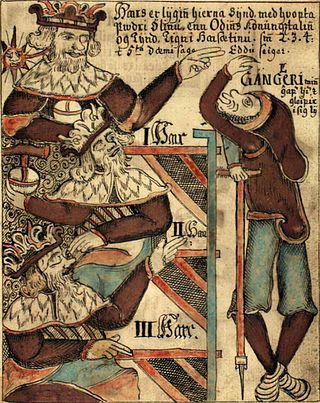
Hár, Jafnhár, and Þriði are three men on thrones who appear in the Prose Edda in the Gylfaginning, one of the oldest and most important sources on Norse mythology. Their names translate as High, Just-as-High, and Third in Old Norse, respectively. In the story, King Gylfi, calling himself Gangleri, engages in a test of wisdom with the three, asking them detailed questions about the Æsir, their deeds, and their future. The three respond until the final segment, in which the three men and the great hall suddenly disappear.
In Norse mythology, the sister-wife of Njörðr is the unnamed wife and sister of the god Njörðr, with whom he is described as having had the twin children Freyr and Freyja. This shadowy goddess is attested to in the Poetic Edda poem Lokasenna, recorded in the 13th century by an unknown source, and the Heimskringla book Ynglinga saga, a euhemerized account of the Norse gods composed by Snorri Sturluson also in the 13th century but based on earlier traditional material. The figure receives no further mention in Old Norse texts.